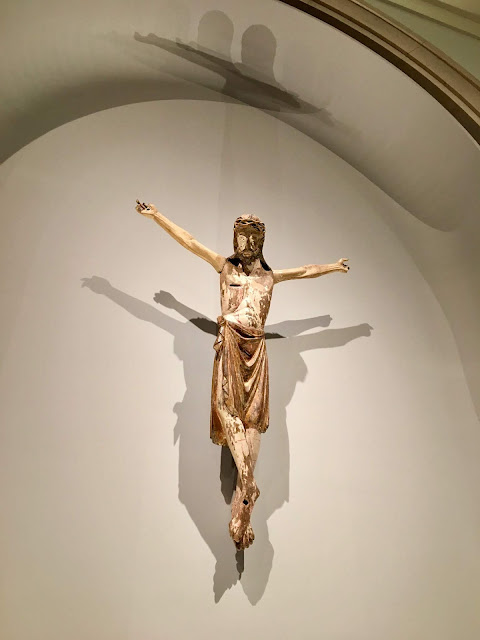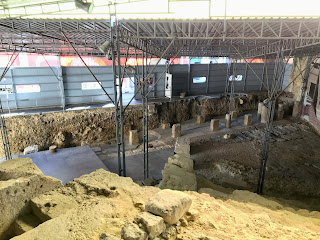September has been quite a month. So much has happened: new school year started, new iPhones came out, and Congress launched an impeachment investigation of the President. Cool. While all that was going on, we moved into our apartments and took an intensive Portuguese class at the University of Lisboa ICLP. There was quite a lot of homework, or as the Portuguese say, "TPC", so it's been hard to take time to write. So this is a catch-up blog post.
Also, last night, Donna found out that her visa was approved, so that's a huge check box ticked. It does mean that she'll need to return to San Francisco to finish the paperwork, but at least things are moving.
Along with the classes, the University course also offered a series of Atividades Culturais, so we got free guided tours of some unusual places around Lisbon. Despite the homework, we thought it inexcusable not to attend these field trips – so please join us.
A big "obrigado" to the program staff at ICLP, who were fantastic organizers and tour leaders.
Visita a Óbidos
We start with a quick and casual return trip to Óbidos. When we visited last, there was a strange dragon (dinosaur? lizard monster?) behind the Castelo, which negated any reasonable photo from that side. It might have been a theater prop. No dragon this time, so I am able to take a good, "full-faced" photo, and it really looks just the way castle ought to look. You can see the over-sized central window for what must be a very special room in the Pousada.
Also closed last time, the small bookstore next to the Castelo is in a converted church. This time it is open, so I am able to add some images here. It's the Livraria de Santiago, though the church's name is Igreja de São Tiago (St. James, 12th century), and it is charming, but the lofts and stairs that are inserted don't really make for a great bookstore experience. Still interesting to see how historical spaces with culture importance are being re-purposed in this tourism-heavy economy.
Visita ao Museu José Maria da Fonseca
There next school trip is to a historic winery and manor house (late 1600's). Museu José Maria da Fonseca is in the small village of São Lourenço, in the area to the south of Lisbon known as Setúbal. Again, a beautiful little village, and a wonderful house and vineyard, but the tour is a bit confined (we cannot wander around the gardens on our own). After a a few stops inside the spooky old aging rooms, we are funneled into the gift shop. Quite a lot of wine is tasted and bought. But we spend our time in the village, looking at the old houses with their gardens, the adorable village squares, and the well-kept church across the street (Igreja Paroquial de São Lourenço), which has quite a few good tiled panels. Though we don't drink, it's still a fun and relaxing visit.
Visita Guida ao Museu Nacional de Arte Antiga
Now this is a real museum-goer's museum. The Museu Nacional de Arte Antiga is in the Madragoa neighborhood, along the river, kinda-sorta near the Basílica da Estrela. It's a large building, with a nice garden facing the river, and views out to the docks and bridges. Inside, we are told about the Age of Discovery and all the booty that went with it – all the stories from far-away places are on display in the objects and art work: vases and china, furnishings, jewelry, and several very fine Japanese screens.
That we can see, almost all the art is from the early and high renaissance, which coincides with the Age of Discovery. We particularly enjoy the sculptures in the upper stair atrium. This leads to the prominent display of the Saint Vincent Panels (Os Painéis de São Vicente) by Nuno Gonçalves – a Portuguese national treasure. With nearly sixty portraits in the six-panel polyptych, the interpretation goes on for a while, and we cannot keep up with the guide, but there is a large interactive touch-screen that helps explain the people in the painting, and some of the portraits that have been over-painted. There are some wall labels in English, too.
Our guide also spends quite some time at the painting of Santo Agostinho by Piero della Francesca, a wonderfully grumpy-looking man in a colorful robe, rendered with amazing detail by the artist – a portrait of a man wearing a whole bunch of other portraits (including in the mitre).
There is high portrait-density here.
Visita ao Palácio dos Marqueses de Fronteira e Alorna
The school then arranges a special tour of the Marqueses de Fronteira e Alorna; we are guided both inside and out (we cannot take photos inside). The entrance is through a kind of Palladian facade, though the classical orders don't seem proportioned quite right. There is a courtyard there, and a tall gate that is open at the left-hand side. A quick peek provides a jaw-dropping view of the formal gardens, which are absolutely immaculate.
We enter up a small set of stone steps, to a stair hall with a sculpted fountain surrounded by tiles; the walls are covered in trompe-l'oeil panels. On the piano nobile, there is a comfy old library facing the garden, filled with old globes, stereoscopic viewers, and of course lots of old books (they look *rather* valuable). Adjacent to this, back through the stair hall, is a tall, grand room full of enormous tile panels, and strange, 3-D-ish relief portraits. I think the guide is explaining some ceremony or coronation, but when I get up close, I can see there are gruesome battle scenes. This is the Hall of Battles, and part of me wonders why these are in a private residence.
We are taken through the dining room, and learn about the restoration taking place there (especially the decorated ceiling). Most of the surfaces are dulled by neglect, but in patches, are colorful and brightly patterned. There are stripes of tissue paper overlaid in the corners and on some of the plaster reliefs that are yet to be removed. It's easy to imagine that the fully restored room will be a real treat. Past the dining room, there are smaller sitting rooms with family pictures and memorabilia. Then returning through the dining room, we are released onto the terrace and into the garden.
These informal facades are absolutely covered in azulejos tiles, sparkly rocks and shells, bits of broken tiles, and large figured sculptures. It is *stun-ning*. Somehow visually chaotic in detail, but also a calming gateway, taken as a whole, to the park. At the far end of the tiled terrace is a small chapel, and a set of stairs down, past the fountains and planter boxes, and to the gardens themselves. You may click the pictures below to see, but there is so much more to this garden. It feels as if we could spend days in here.
Visita ao Teatro Romano
The final trip is to the Museu de Lisboa: Teatro Romano, and I am not exactly sure what to expect. The image in the course catalog only shows a big sign with the museum's name. Images I can find online show the Theater's reconstruction, and only a few show the Museum itself. We take the Metro to Terreiro do Paço (Praça do Comércio) and walk up towards the Sé. The Teatro Romano (Felicitas Iulia Olisipo) is just uphill from the Sé.
When we arrive, we find a clean, new museum running through and over an archaeological dig site, with exposed Roman masonry work about twenty feet below the street level. Across the street, behind a construction fence of "theater masks" (the openings in the walls are the "mouths" of the masks) is the theater dig site, and it is *fascinating*. About one third of the semi-circle is exposed; the theater servers the Roman city of Olisipo, from the Greek Ulyssippo, and could seat about 4,000 in the day (1st century AD). The apartment buildings just uphill from this site must sit atop the rest of the theater; the building immediately adjacent appears to be vacant, so maybe there's more digging ahead.
Back across the street, and next door to the Museum, I see a man clearing construction debris, and then realize the debris is from the dig site below the street that they are continuing to expand. This Museum is not done growing.
Inside the Museum itself, the architectural drawings, models, graphic reconstructions, and artifacts bring everything to life. A deeply interesting place, and it's clear how much work has gone into the excavation, the research, and even the Museum; but we have exams the next day and think better of lingering too long. We'll return here soon.
Igreja de Santo António e Sé de Lisboa
On our way back, we learn that one of our fellow students has not been to the Sé, so we pop inside for a quick look. We then realize that the neighboring church, the Igreja de Santo António, is open. During our past visits, this church was always closed - so we decide to pop in there, too. I feel the study time slipping away, but don't really mind if there's a good church to see.
The Igreja de Santo António is a compact neo-classical church, with truncated transepts due to the narrow site. It's built over a crypt which marks the birth place of Saint Anthony, which explains why you build a fancy little church right in front of the Lisbon's Cathedral. The dome is a delightful surprise; from the outside you don't expect a big, tall dome.
During our previous trips in 2017, the Sé was dark and a little under-whelming. Happy now to report that the interior lighting seems to be greatly upgraded, and the church is much more lively - more details in the upper galleries are visible, and the baptismal font and a side chapel with some impressive stained glass panels are now open for public view. There is also an archaeological dig in the back garden and cloisters of the church, and a series of back-lit screens explains what's going on.
Evidently, the upper and lower cloisters suffered some kind of collapse, and in digging out the repairs, they found the ruins of a Phoenician-era trading post (1200 BC). So, I think they are restoring the cloisters *on top of* a new museum that will showcase the old site.
It's very good to know that Lisbon is re-investing all the tourist money poring into the city this way. Finding and exposing its history, researching and conserving its cultural roots, and then offering those stories back to the public through these beautiful new museums. All while allowing the city, and its tourism, to thrive. Lisbon is definitely doing it right.








































No comments:
Post a Comment